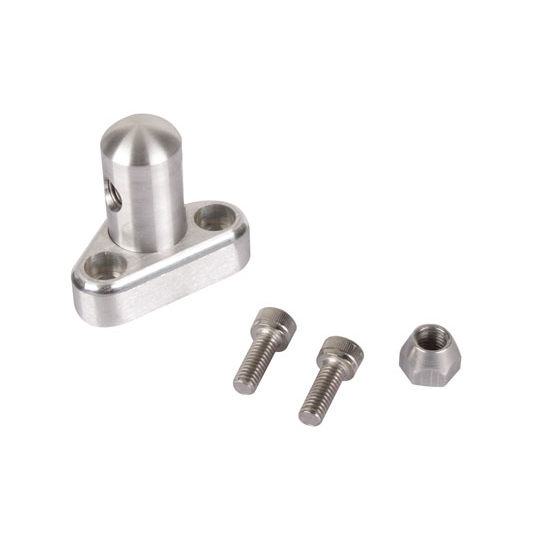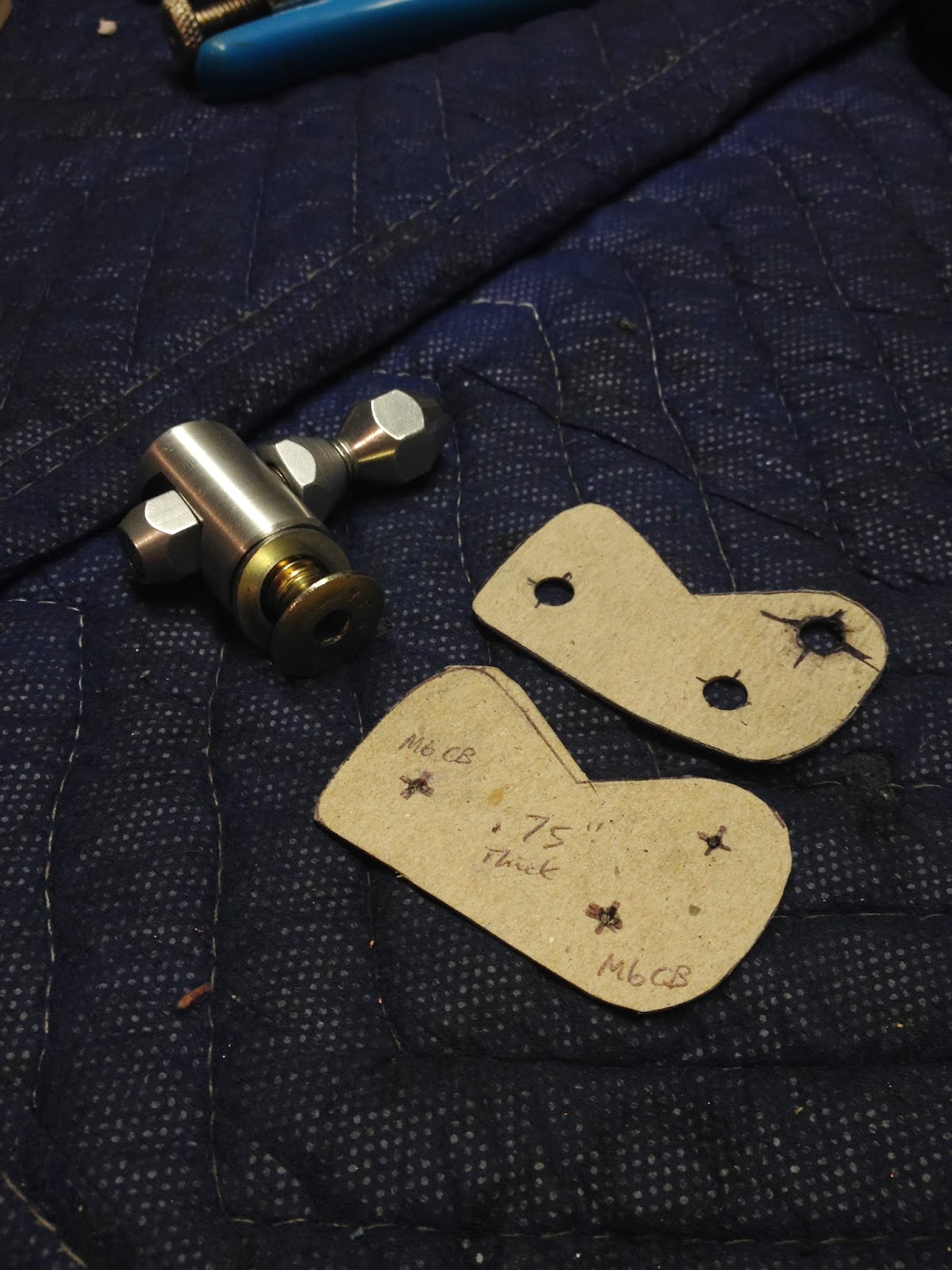Engine Build
The Pushrod Length / Lifter Preload Saga
Been a while since my last update, but I've made some progress as of late.
Buying a cheap magnetic base indicator stand from harbor freight solved all of my preload measurement problems. You have to have this absolutely dead-nuts aligned with the "preload column" and be extremely careful with how you tighten everything down to get repeatable numbers, but I was able to confirm my expected preload numbers to within .0015" or so.

This allowed me to assume that my improvised way for measuring pushrods was not only accurate, but produced the exact preload on the engine that I was expecting. To summarize, I cobbled together a way of measuring gauge length directly with a pair of 8" calipers by gluing some small pieces of steel to the jaws that were drilled for a .140" hole. In theory, the circumference of the holes would bisect the ball-end of the pushrod at the .140" diameter (gauge length), thus negating any effect the size of the oil hole has on overall length. This is the industry standard for measurement, given that oil hole diameter varies manufacturer to manufacturer.

With that knowledge, I ordered the entire set of my pushrods to the appropriate lengths from Trend performance. I ended up a dual taper push rod, 3/8" - 5/16" fully machined 210 degree ball ends with a .135" wall. These rods are stiffer than an 11/32" rod, but lighter than a full 3/8" rod. A pretty good compromise, given that I can't fit full 3/8" rods through my heads. I needed the beefier pushrods on my build to help to ensure reliable valve motion by minimizing deflection and the "pole vaulting" effect that leads to lofting. I am not running the most aggressive lobes on my cam, but they're certainly not he mildest either.

The engineer that designed the lifters I'm using (Johnson LSR's) recommended a target preload on my lifters at .025-.030" (verified by Spintron testing) and brought about the need for verifying all of my measurements to the nth degree - tolerances can get way out of control otherwise and really add up for undesirable effects. I removed all the error I could from my measurements, and after speaking with Trend, they told me that they were able to hit 001"-.005" on custom length rods due to expansion during machining. With this knowledge, I ordered all of my pushrods based on an .030" preload. I made some exceptions when pushrod lengths were similar and ordered common lengths where I could, but all told I ended up with 9 unique lengths across all 16 valves. This way I'd be able to shim the rockers up slightly to bring my preload down if necessary if they're cut too long. All I could do was hope they didn't cut them too short.
Here's what I received. This strategy seemed to work really well, as they were able to hit their targets within a few thou. Below is a summary of my results.
Low is .023", max is 0.033". For the low one, I may machine some rocker shims to the precise thickness I need to bump up the preload slightly - there about a .010" window of forgiveness in height either direction before I start negatively affecting my wipe pattern on the valve tip. I would consider ordering another pushrod but there's no guarantee this would solve the problem, so I'll save my money. The #8 cylinder will get an additional .003" rocker shim to bring those preloads within spec (.030/.027" respectively). Some small adjustments to make, and honestly I'm not sure if they're even significant adjustments (will the lifters care?), but it should provide me with as close to an optimized setup as I can achieve.
Finish Work.
With all the intense measurement critical stuff done on the engine, now I have to do all of the "finish" detail work for the exterior. Below is the shortlist of things to get done before I can button her all the way up.
- Powder coat valve covers, oil pan, front timing cover, AC bracket, alternator bracket
- Clean up accessories and starter motor, and order belts
- Fuel injector rail clips
- Ignition wires and remote mount of ignition coils (may need to wait until the engine is in the car)
- Coolant steam port vent line build (front and rear) for cylinder heads
- Catch can and PCV system routing
- Oil cooler adapter
- Oil / coolant sensor setup. I'll be running some VDO gauges so I can keep track of oil pressure, temperature, and water temperature in real time.
- Throttle cable / cable bracket
- LS1 +04 2-piece thermostat. I bought both 180 and 160 degree thermostats, not sure which I'll use yet but I'll have the option!
- Layout and clean up wiring harness
- Base tune on PCM
Bunch of parts are on the way, will post up when they arrive.
Teaser shot of the engine in mockup
Chassis Integration
With all of that pretty much on hold until I gather everything up to go to powder coat, I started figuring out what I wanted to do in terms of chassis integration.
Lots to figure out...
- Fuel supply
- Power steering adaptation
- Compact steering shaft
- Clutch hydraulic integration
- Electrical and PCM wiring
- Oil cooler setup
- Cooling / heater core system integration
- Braking system
- EVAP / Emissions stuff for OBDII compliance
After a lot of research though I was able to make some pretty decent headway in wrapping my head around all the details - a lot of which isn't explicitly posted.
I'm using this space as a placeholder for my ideas / train of thought at the moment, but in case you care:
- Fuel supply
- Corvette FPR. (Filter / regulator) - regulates pressure to 58 psi.
- Rally Road HFP 300lph Fuel Pump Kit. Drops right into the stock pump location.
- Stainless hard lines
- Stainless hose from FRP to fuel rail
- -6AN fitting throughout (which means I'll need to get 37 degree flaring tools for the hardline to use AN tube nuts / sleeves). They make "hardline adapters" but they're not rated for more than 50 psi, and I'd rather not develop a fuel leak.
- Power steering adaptation
- Pretty simple - AN high pressure hose from pump to rack. Will need to TIG -AN fitting to power steering "cooler" tube.
- Compact steering shaft
- Needed to help with header clearance and help eliminate heat affect on rubber rag joint of the stock piece (no headers on drivers side originally)
- Flaming River chromoly U-joints
- Borgeson telescoping DD shaft
- Clutch hydraulic integration
- Bought some nifty adapters for the T56 TOB to adapt to standard -AN lines
- Speedbleeder (moves bleeder screw into engine bay instead of under car somewhere)
- Rally Road Tilton 7/8" MC kit. I like a firm pedal. The stock M3 master is reported to be too soft with the LS clutches.
- Electrical / Sensors / PCM wiring
- No idea on wiring pinouts yet
- Bought an SA-1000 standalone relay/fuse block
- Oil pressure sending unit adapter for stock location. The idiot "low pressure" light is useless to me, I'd rather read out on a VDO gauge and know what the pressure is at all times.
- Oil temperature - port in oil cooler adapter for that (in the pan). This will also let me know when the thermostat opens to allow oil to flow through the cooler. VDO gauge again.
- Water temperature - BMW sensor to drivers side head for gauge in dash. Another sensor on passenger side head for readout on VDO gauge.
- Oil cooler setup
- Improved racing low-profile oil cooler adapter / thermostat
- Setrab cooler and fittings (need to decide on size).
- Braided stainless lines / -AN fittings
- Cooling / heater core system integration
- Braking system
- Rally road kits - Corvette Z06 6-piston fronts with DBA-5000 2-pc hats, Porsche brembo rears.
- ABS will be retained
- All lines will be remade from stainless.
- EVAP / Emissions stuff for OBDII compliance
- PCV is pretty straight forward. Need to figure out exact routing and whether or not I need to use the check valve.
- EGR is deleted (tuned out)
- AIR is also deleted (tuned out)
- Cats
- Pre / post O2 sensors
- Evap line from BMW charcoal canister will be connected to LS vapor purge solenoid
- GM fuel tank sensor. Required to let the GM engine PCM control the BMW charcoal canister.
For a '99 model year, I am allowed to have two non-functioning emissions systems in a scan for "device readiness". I intend for EGR and AIR to be those two - though the one caveat is that I don't think there is an AIR system on the M3, so I'm not sure if that will count as an "offender" in this case. EGR is useless - basically only runs for the first 5 minutes until the O2 sensors get up to temp.
Trying to get all the details ironed out now to make the swap as straight forward as possible once I start. I'm trying to get this done by the fall, or at least driveable.
































